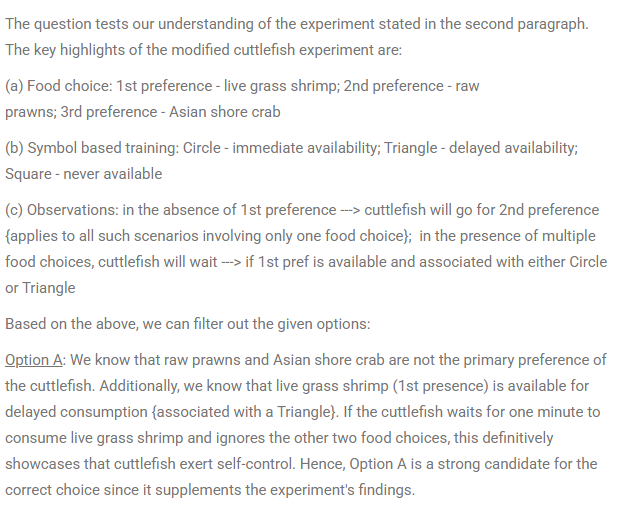CAT RC Questions | CAT RC- Social Science questions
FundaMakers is the Best CAT Online Coaching In India. Now prepare for CAT anytime with FundaMakers. We provide well-ordered syllabus coverage for both offline and online CAT preparation batches. FundaMakers brings to you the power-packed, well-structured CAT previous year question bank with more than 4000+ CAT Past Year questions. In the VARC section, one of the most frequently asked questions is from the topic- Reading Comprehension. Reading Comprehension turns out to be an important part of the VARC section from which over 60-70% of the questions are based on RC in the CAT Exam.
FundaMakers as a team has taken a painstaking step to bring you all the video solutions of the Reading Comprehension asked in the Previous Year CAT exam. CAT question bank offered by FundaMakers is a power-packed topic-wise compilation of the entire CAT previous year questions. Questions from the Reading Comprehension topic are some of the most scoring questions in the VARC section. To maximize your CAT score make use of FundaMakers CAT Question Bank. “Questions from CAT previous years” examination papers have been incorporated. Let’s get started with CAT Past Year Reading Comprehension Questions.
Comprehension
The passage below is accompanied by a set of questions. Choose the best answer to each question.
Cuttlefish are full of personality, as behavioral ecologist Alexandra Schnell found out while researching the cephalopod's potential to display self-control. . . . “Self-control is thought to be the cornerstone of intelligence, as it is an important prerequisite for complex decisionmaking and planning for the future,” says Schnell . . .
[Schnell's] study used a modified version of the “marshmallow test” . . . During the original marshmallow test, psychologist Walter Mischel presented children between age four and six with one marshmallow. He told them that if they waited 15 minutes and didn’t eat it, he would give them a second marshmallow. A long-term follow-up study showed that the children who waited for the second marshmallow had more success later in life. . . . The cuttlefish version of the experiment looked a lot different. The researchers worked with six cuttlefish under nine months old and presented them with seafood instead of sweets. (Preliminary experiments showed that cuttlefishes’ favorite food is live grass shrimp, while raw prawns are so-so and Asian shore crab is nearly unacceptable.) Since the researchers couldn’t explain to the cuttlefish that they would need to wait for their shrimp, they trained them to recognize certain shapes that indicated when a food item would become available. The symbols were pasted on transparent drawers so that the cuttlefish could see the food that was stored inside. One drawer, labeled with a circle to mean “immediate,” held raw king prawn. Another drawer, labeled with a triangle to mean “delayed,” held live grass shrimp. During a control experiment, square labels meant “never.”
“If their self-control is flexible and I hadn’t just trained them to wait in any context, you would expect the cuttlefish to take the immediate reward [in the control], even if it’s their second preference,” says Schnell . . . and that’s what they did. That showed the researchers that cuttlefish wouldn’t reject the prawns if it was the only food available. In the experimental trials, the cuttlefish didn’t jump on the prawns if the live grass shrimp were labeled with a triangle— many waited for the shrimp drawer to open up. Each time the cuttlefish showed it could wait, the researchers tacked another ten seconds on to the next round of waiting before releasing
the shrimp. The longest that a cuttlefish waited was 130 seconds.
Schnell [says] that the cuttlefish usually sat at the bottom of the tank and looked at the two food items while they waited, but sometimes, they would turn away from the king prawn “as if to distract themselves from the temptation of the immediate reward.” In past studies, humans, chimpanzees, parrots and dogs also tried to distract themselves while waiting for a reward.
Not every species can use self-control, but most of the animals that can share another trait in common: long, social lives. Cuttlefish, on the other hand, are solitary creatures that don’t form relationships even with mates or young. . . . “We don’t know if living in a social group is important for complex cognition unless we also show those abilities are lacking in less social species,” says . . . comparative psychologist Jennifer Vonk.
CAT/2021.1
Question . 107
In which one of the following scenarios would the cuttlefish’s behaviour demonstrate self-control?
Explanatory Answer
Method of solving this CAT RC Question from RC- Social Science question
Correct Option: A

Hey!
Worried about IIM calls due to your marks in 10th,12th, and Graduation?
Don't worry! Know your chances of getting an IIM Call based on your profile with our:-
Profile Professor: https://fundamakers.com/profile-professor/

5 Must- NOT-Dos during CAT Preparation.
- Do not treat CAT as 'Everything'.
- Do not quit your job for CAT exam preparation.
- Learning till The Eleventh hour instead of doing proper revision.
- Not checking the syllabus thoroughly.
- Piling up multiple books.
Click To Read:- Common mistakes made by CAT aspirants during preparation.
FundaMakers- Best Online and Offline CAT Online Preparation Institute in India
For any CAT Preparation related query, reach out to us at 9598333344.